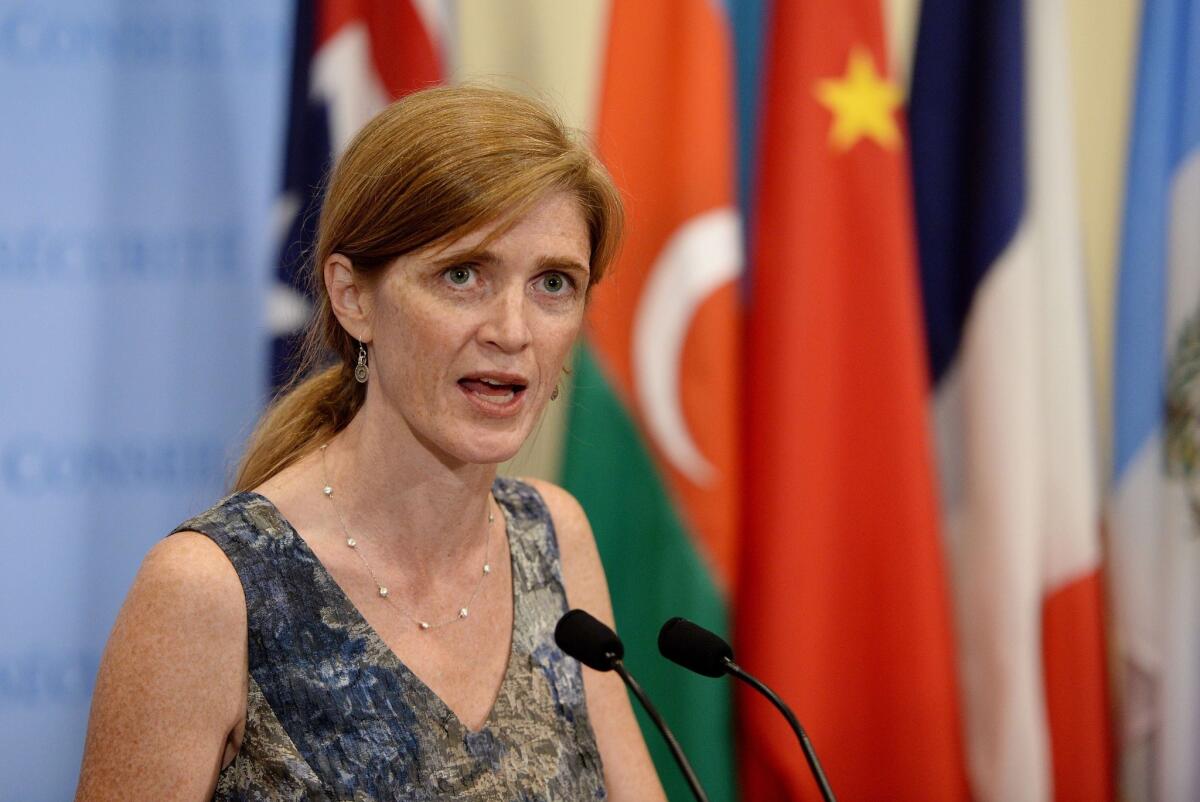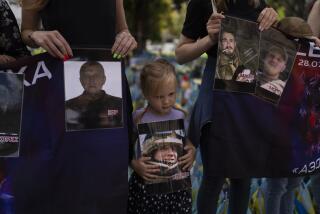U.N. report on sarin attack in Syria points to Assad, envoys say

A United Nations report concluding that chemical weapons were used in Syria on Aug. 21 contains evidence pointing to Syrian President Bashar Assadâs forces as the perpetrators, the U.S. and British ambassadors to the world body said Monday.
U.N. Secretary-General Ban Ki-moon declined to say whether rocket fragments and other physical evidence collected from a Damascus suburban area by U.N. investigators made it clear whether it was the Assad regime or the rebels fighting him who launched the sarin gas attacks.
But U.S. Ambassador Samantha Power and British U.N. envoy Mark Lyall Grant stated unequivocally that the inspectorsâ findings confirmed their conclusions that it was Assad who was behind the worst chemical weapons attack in 25 years.
âThe mandate of the chemical weapons team was not to investigate culpability, but the technical details of the United Nations report make clear that only the regime could have carried out this large-scale chemical weapons attack,â Power told reporters after Ban briefly discussed the report.
DOCUMENT: U.N. report on chemical weapons use in Syria
Among the weapons fragments and components recovered from the scene of the attacks were pieces of 122-millimeter rockets that the regime has relied on heavily throughout the civil war and that the rebels are not known to possess, Power said.
She also dismissed a claim by the Assad government that insurgents infiltrated regime-controlled areas of the capital to launch the poison gas strikes as a scenario that âdefies logic.â
Grant said the type of rockets used in the attacks and the area from which they were fired confirmed that âthere is no remaining doubt that it was the regimeâ that attacked with prohibited munitions.
âEven at first glance, the report reinforces the view that the British government has held for a long time that it was the regimeâs responsibility,â he told reporters.
Both Western envoys noted the sarin attacks near Damascus were the most wide-scale violation of the chemical weapons ban since Iraqi President Saddam Hussein attacked Kurds with poison gas in 1988.
Russiaâs U.N. envoy, Vitaly Churkin, expressed outrage at the confirmed use of chemical weapons in the attacks nearly a month ago but warned that âallegations that the opposition has used chemical weapons cannot be shrugged off.â
Russia is Assadâs most powerful ally and key arms supplier, and Moscow has thwarted numerous previous attempts by the Security Council to sanction Assad for brutality against his own people.
The inspectorsâ 41-page report, posted on the U.N. website, cited blood, urine and hair samples taken from 36 survivors of the attacks as providing âdefinitive evidence of exposure to sarin by almost all survivors assessed by the mission.â
Ban presented the report to the U.N. Security Council behind closed doors before giving a brief summary to reporters and taking a few questions.
U.N. inspectors found âclear and convincing evidenceâ that sarin gas was used to attack rebel-held suburbs of the Syrian capital, Ban said. He praised the investigators for braving sniper fire and other hazards during their two-week mission to Syria, which began before the sarin attacks that killed more than 1,400, by U.S. account.
Ban called the use of sarin-carrying rockets a war crime that would not be allowed to pass with impunity. However, he deflected questions about how the U.N. should proceed to ensure there is accountability for those who used chemical weapons in defiance of international law.
The result of the probe âleaves us with the deepest concern,â the inspectors, led by Swedish biological and chemical arms expert Ake Sellstrom, stated in a letter to Ban accompanying their report.
âThe conclusion is that chemical weapons have been used in the ongoing conflict between the parties in the Syrian Arab Republic ... against civilians, including children, on a relatively large scale,â the report said.
âIn particular the environmental, chemical and medical samples we have collected provide clear and convincing evidence that surface-to-surface rockets containing the nerve agent sarin were used,â it said.
Sellstrom delivered the report to Ban on Sunday, a day after the top diplomats from the United States and Russia agreed on a plan to bring Syria into compliance with the 1993 Chemical Weapons Convention and surrender its nerve agents and poison gases to international control and eventual destruction.
The framework agreed to by Secretary of State John F. Kerry and Russian Foreign Minister Sergei Lavrov calls for Assad to declare the quantity and location of his chemical arsenal immediately and for the gases and nerve agents -- more than 1,000 tons, according to official estimates -- to be handed over to international control by the middle of next year.
Meanwhile, in Geneva, the head of the U.N. commission probing war crimes allegations disclosed that 14 other suspected chemical attack sites in Syria are under investigation.
Paulo Sergio Pinheiro, the war crimes commission chief, said investigators have found evidence of war crimes committed by both Assadâs forces and rebel groups.
ALSO:Capsized Costa Concordia slowly being righted
Egyptian security forces storm community held by Morsi supporters
Israel legal ruling lets Palestinians reclaim former Jewish settlement
Twitter: @cjwilliamslat
More to Read
Sign up for Essential California
The most important California stories and recommendations in your inbox every morning.
You may occasionally receive promotional content from the Los Angeles Times.











